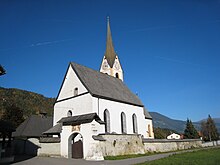Sachsenburg (Carinthia)
|
market community Sachsenburg
|
||
|---|---|---|
| coat of arms | Austria map | |
|
|
||
| Basic data | ||
| Country: | Austria | |
| State : | Carinthia | |
| Political District : | Spittal an der Drau | |
| License plate : | SP | |
| Surface: | 42.59 km² | |
| Coordinates : | 46 ° 50 ' N , 13 ° 21' E | |
| Height : | 557 m above sea level A. | |
| Residents : | 1,322 (January 1, 2020) | |
| Population density : | 31 inhabitants per km² | |
| Postal code : | 9751 | |
| Area code : | 0 47 69 | |
| Community code : | 2 06 33 | |
| NUTS region | AT212 | |
| Address of the municipal administration: |
Marktplatz 12 9751 Sachsenburg |
|
| Website: | ||
| politics | ||
| Mayor : | Wilfried Pichler (AG) | |
|
Municipal Council : ( 2015 ) (15 members) |
||
| Location of Sachsenburg in the Spittal an der Drau district | ||
| Source: Municipal data from Statistics Austria | ||
Sachsenburg is a market town with 1,322 inhabitants (as of January 1, 2020) in the Spittal an der Drau district in Carinthia .
geography
The community is located at the exit of the upper Drautal on the Lurnfeld . The Kreuzeck Group is to the northwest of Sachsenburg and the Goldeck to the southeast .
Community structure
The municipality of Sachsenburg with the two cadastral municipalities Sachsenburg and Obergottesfeld consists of five localities (number of inhabitants in brackets as of January 1, 2020):
- Feistritz (56)
- Lance jokes (3)
- Nigglai (6)
- Obergottesfeld (186)
- Sachsenburg (1071)
Neighboring communities
| Reisseck | Mühldorf | Lurnfeld |

|
Baldramsdorf | |
| Steinfeld | Kleblach-Lind |
history
The area around Sachsenburg was strategically important even in Roman times. Around 1200 two castles were built on the fortress mountain. The first written reference dates back to 1213. One possible explanation for the place name is based on Saxony- on thing within the meaning of Case due, so Sachsenburg Castle, where the court sits could mean. The first settlement of traders and tradespeople was probably in the early 13th century at the fork of the Drau and Möll valley. The seat of a Salzburg archbishop's office has been documented here for 1292 and from 1326 Sachsenburg is referred to as a market, which was also walled in 1358.
In 1765 , Empress Maria Theresa received petitioners from the immediate vicinity of the empire in the house at number 7 .
In March 1848 Josef Klaus and Gottlieb Supersperg proclaimed the Republic of Sachsenburg with the slogan "Freedom, Equality, Fraternity" in the course of the March Revolution . After a month, a company of soldiers from the Sachsenburg republic put an end to it. During this time stagecoaches were prevented from passing and the citizens of Sachsenburg refused to pay taxes.
The market community of Sachsenburg was constituted in 1850, to which the local community of Pusarnitz was temporarily affiliated from 1865 to 1889. During the municipal reform in 1973, Pusarnitz, Möllbrücke and a large part of the municipality of Sachsenburg were combined to form the new market town of Lurnfeld . After a referendum in 1992, Sachsenburg became independent again.
Attractions
- Sachsenburg fortification
- Parish church hl. Magaretha in Sachsenburg
- Calvary Sachsenburg with Holy Sepulcher Chapel
- Filial church hl. Ruprecht in Obergottesfeld
population
At the time of the 2001 census, Sachsenburg had 1,438 inhabitants, 92.1% of whom were Austrian, 2.9% Turkish and 1.8% Bosnian citizens. 83.1% of the population professed the Roman Catholic and 8.5% the Protestant Church, 5.9% Islam . 1.2% were without religious belief.
politics
Municipal council
The municipal council of Sachsenburg has 15 members and has been composed as follows since the municipal council election in 2015 :
The action group Markt Sachsenburg (AG) is a list of names. Since 2009 she has been on a joint list with the BZÖ and the FPÖ. The directly elected mayor is Wilfried Pichler (AG, previously AG / BZÖ).
coat of arms
The use of a seal has been made available since the middle of the 16th century and is proven on a document dated April 17, 1742. It shows a Saxe or Multer, an elongated wooden device that was used for panning for gold, which alludes to the gold panning that was common in Upper Carinthia in the Middle Ages (here especially in the Siflitzgraben) and the place names that may have been derived from it.
In a first coat of arms and flag award document in 1973, minerals separated by the Saxe were also marked and emblazoned, which was omitted when the community was re-awarded after the re-establishment of independence. The blazon of the coat of arms in the award document of October 3, 1995 reads: "In blue diagonally right a golden Saxe." The flag is blue and yellow with an incorporated coat of arms.
Town twinning
Web links
- Market town of Sachsenburg
- 20633 - Sachsenburg (Carinthia). Community data, Statistics Austria .
Individual evidence
- ↑ Statistics Austria: Population on January 1st, 2020 by locality (area status on January 1st, 2020) , ( CSV )
- ↑ The meaning and distribution of Bavarian place names. In: bairische-sprache.at. Retrieved July 17, 2017 .
- ↑ Statistical information based on municipal data , as of 2001 census from Statistics Austria
- ↑ The Sachsenburg seal shows formal similarities with the Feldkirchen market seal , so that one concludes that it was granted a coat of arms by Archbishop Ernst (r. 1540–1554).
- ^ Quoted from Wilhelm Deuer: The Carinthian municipal coat of arms . Verlag des Kärntner Landesarchiv, Klagenfurt 2006, ISBN 3-900531-64-1 , p. 238








